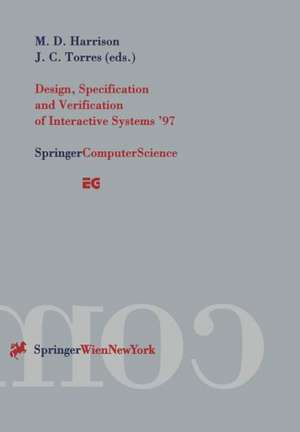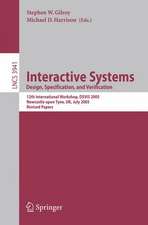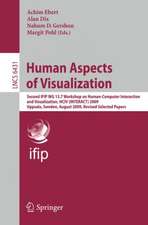Design, Specification and Verification of Interactive Systems ’97: Proceedings of the Eurographics Workshop in Granada, Spain, June 4–6, 1997: Eurographics
Editat de Michael D. Harrison, Juan C. Torresen Limba Engleză Paperback – 11 noi 1997
Din seria Eurographics
- 20%
 Preț: 651.42 lei
Preț: 651.42 lei - 20%
 Preț: 643.17 lei
Preț: 643.17 lei - 20%
 Preț: 645.65 lei
Preț: 645.65 lei - 18%
 Preț: 949.73 lei
Preț: 949.73 lei - 20%
 Preț: 647.93 lei
Preț: 647.93 lei - 20%
 Preț: 324.64 lei
Preț: 324.64 lei - 20%
 Preț: 337.85 lei
Preț: 337.85 lei - 20%
 Preț: 643.83 lei
Preț: 643.83 lei - 20%
 Preț: 644.15 lei
Preț: 644.15 lei - 20%
 Preț: 656.03 lei
Preț: 656.03 lei - 20%
 Preț: 644.48 lei
Preț: 644.48 lei - 20%
 Preț: 645.14 lei
Preț: 645.14 lei - 20%
 Preț: 328.42 lei
Preț: 328.42 lei - 20%
 Preț: 336.86 lei
Preț: 336.86 lei - 20%
 Preț: 335.52 lei
Preț: 335.52 lei - 20%
 Preț: 342.78 lei
Preț: 342.78 lei - 20%
 Preț: 336.86 lei
Preț: 336.86 lei - 20%
 Preț: 328.60 lei
Preț: 328.60 lei - 20%
 Preț: 339.66 lei
Preț: 339.66 lei - 20%
 Preț: 335.88 lei
Preț: 335.88 lei - 20%
 Preț: 331.74 lei
Preț: 331.74 lei - 20%
 Preț: 327.77 lei
Preț: 327.77 lei - 20%
 Preț: 334.53 lei
Preț: 334.53 lei - 20%
 Preț: 340.32 lei
Preț: 340.32 lei - 20%
 Preț: 329.58 lei
Preț: 329.58 lei - 20%
 Preț: 330.24 lei
Preț: 330.24 lei - 20%
 Preț: 338.03 lei
Preț: 338.03 lei - 20%
 Preț: 337.66 lei
Preț: 337.66 lei - 20%
 Preț: 340.49 lei
Preț: 340.49 lei - 20%
 Preț: 331.58 lei
Preț: 331.58 lei - 20%
 Preț: 336.86 lei
Preț: 336.86 lei - 20%
 Preț: 335.36 lei
Preț: 335.36 lei - 20%
 Preț: 339.66 lei
Preț: 339.66 lei - 20%
 Preț: 329.26 lei
Preț: 329.26 lei - 20%
 Preț: 327.12 lei
Preț: 327.12 lei - 20%
 Preț: 339.34 lei
Preț: 339.34 lei
Preț: 336.67 lei
Preț vechi: 420.84 lei
-20% Nou
Puncte Express: 505
Preț estimativ în valută:
64.42€ • 67.44$ • 53.30£
64.42€ • 67.44$ • 53.30£
Carte tipărită la comandă
Livrare economică 05-19 aprilie
Preluare comenzi: 021 569.72.76
Specificații
ISBN-13: 9783211830550
ISBN-10: 3211830553
Pagini: 336
Ilustrații: VIII, 320 p. 56 illus.
Dimensiuni: 170 x 244 x 18 mm
Greutate: 0.54 kg
Ediția:Softcover reprint of the original 1st ed. 1997
Editura: SPRINGER VIENNA
Colecția Springer
Seria Eurographics
Locul publicării:Vienna, Austria
ISBN-10: 3211830553
Pagini: 336
Ilustrații: VIII, 320 p. 56 illus.
Dimensiuni: 170 x 244 x 18 mm
Greutate: 0.54 kg
Ediția:Softcover reprint of the original 1st ed. 1997
Editura: SPRINGER VIENNA
Colecția Springer
Seria Eurographics
Locul publicării:Vienna, Austria
Public țintă
ResearchCuprins
Do interactive systems need specifications?.- PAC-ing the architecture of your user interface.- DMVIS: Design, modelling and validation of interactive systems.- Users as rational interacting agents: Formalising assumptions about cognition and interaction.- Establishing a link between usability and utility: Validation of task-based dialogue using a semantic prototype.- Evaluating narrative in multimedia.- Interactors and Haggis: Executable specifications for interactive systems.- Formally verifying interactive systems: A review.- Investigating the behaviour of PREMO synchronizable objects.- Formal transducers: Models of devices and building bricks for the design of highly interactive systems.- From text to Petri nets: The difficulties of describing accident scenarios formally.- Unifying toolkit programming layers: A multi-purpose toolkit integration module.- Editing MAD* task descriptions for specifying user interfaces, at both semantic and presentation levels.- Formal aspects of task based design.- Reusable structures in task models.- The interaction specification workspace: Specifying and designing the interaction issues of virtual reality training environments from within.- The notion of trajectory in graphical user interfaces.- A representational approach to the specification of presentations.- On biasing behaviour to the optimal.- Modelling in Action. Reports from the DSVIS’97 working groups.
Caracteristici
state of the art in this field























